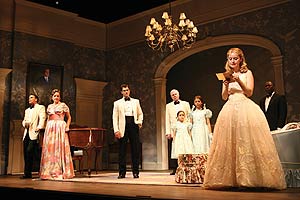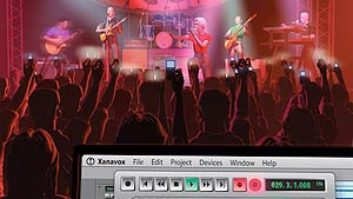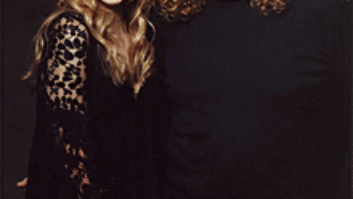
Photo: Joan Marcus
At first glance, a deranged elderly woman and her equally afflicted middle-aged daughter might not seem the likeliest central characters in a musical, but Grey Gardens has drawn rave reviews from both high-minded critics and a flock of Broadway theatergoers.
Based on the 1975 documentary film of the same name by Albert and David Maysles, Grey Gardens explores dementia and family dysfunctionality with wit and humor. Its creators — Michael Korie (lyrics), Doug Wright (book) and Scott Frankel (music) — also flesh out the story of how Edith Ewing Bouvier Beale, the aunt of Jacqueline Kennedy Onassis, and her daughter (also named Edith) fell into squalor in their once magnificent Long Island mansion. Treated with compassion, but also viewed from an intellectually dispassionate perspective, the characters disintegrate before our eyes but manage to retain our affection.
Frankel grew up being attracted to some of the great dramatic composers — Mahler, Strauss, Puccini — as well as Earth, Wind & Fire, Steely Dan and Blood, Sweat & Tears. He attended Yale University, which is where he met Wright. After graduating from Yale, Frankel moved to Manhattan and became a session keyboard player and accompanist. Prior to Grey Gardens, Frankel and Korie had collaborated on two musicals: Doll and Meet Mister Future. “Michael and I almost always write songs by the ‘lyric first’ model,” says Frankel. “His lyrics are incredibly specific and attuned to the dramaturgical needs of the scene and the character. That said, I know that Michael does at least attempt to create a lyric or two that has the potential to be lifted from the show and exist independently from it.”
For financial reasons, the powers that be mandated that Frankel and orchestrator Bruce Coughlin work with a pit orchestra of only nine players. The palette of colors that Frankel and Coughlin were able to draw out of this diminutive ensemble is remarkable. Rather than turn over simple lead sheets, Frankel sketched out detailed arrangement ideas across five staves and handed them off to Coughlin.
“When you’ve got full sections of brass, strings and winds, you can write in blocks of harmony,” Frankel says, “but with so few players, it’s more about individual lines. I had to make sure each interval was satisfying. The result is something of a chamber opera piece, where the band envelops the singer to create a sense of size. Otherwise, the band can feel tiny.”
IN SESSION
The original off-Broadway cast album for Grey Gardens was produced by Tommy Krasker and released on his label, PS Classics. Several new songs were written for the Broadway run, others deleted, and the decision was made to return to Avatar Studios in New York to track the new material with Steve Epstein as producer. Epstein’s longtime colleague Richard King recorded these songs and remixed the entire album.
“I met Scott when I was invited to see the show for the first time,” says Epstein. “I had already listened to the recording of the off-Broadway version by that time and found it very affecting. Scott has the rare talent to write music of substance that is nonetheless appealing to a wide audience.”
The producer and composer needed to first make sure they were in sync. “Cast recordings are a hybrid between pop and classical,” says Epstein. “When you record a musical, you have to make some decisions. Cast albums often end up sounding like karaoke, with a singer slapped on top of an arrangement. Opera recordings, on the other hand, allow the singers to be cushioned against the orchestra, and at times be enveloped by its textures. When opera singers get ‘lost’ in the orchestra, the result is often heightened excitement.
“Operas are generally recorded in a hall, and the environment plays a great part in the overall picture of the final product,” Epstein continues. “When you step into a studio to record a cast album, especially with the slender number of players we used, you’re tasked with the assignment of creating the soundscape.”
Performer placement was key to fulfilling this goal. “Before we conduct a recording session, I like to attend as many performances of a show as possible to get a sense of what’s happening onstage,” Epstein explains. “I take notes in the dark with a tiny flashlight during each tune, scribbling stage activity notes that will help me recall the movement taking place onstage. When we record the performances — and later during the mix — I refer to these notes.”

Engineer Richard King (left) and producer Steve Epstein
Matching the sonic environment of the earlier recordings was essential. “We studied the mic lists from the earlier sessions and recorded the new material using the same setup,” says King. “We used a tube [Neumann] U47 on the main soloists. It’s an extremely versatile mic that works well on both male and female singers, as well as the younger performers. We placed a pair of AKG 414s to capture the piano, used [Sennheiser] MKH40s on the strings and a DPA 4011 for the room pickup. We used RCA ribbon mics on the trumpet and French horn.”
Musicians were positioned in the studio in a configuration similar to their stage positions. “When we mix, we incorporate very slow and subtle pan moves — so slow that you’re not aware of the movement,” says Epstein. “Bad panning is like the overly zealous use of a zoom lens on a video camera. It may be tempting to go back and forth from long shots to close-ups while you’re shooting, but the result can be a piece of footage that’s impossible to watch! The same thing can happen with panning. We’re always keeping in mind the positioning of the actors as they appear onstage and balancing our desire to have the recording reflect the original performance against the fundamental requirement to create a satisfying stereo image.”
“Bruce Coughlin’s orchestrations for this show are terrific,” King adds. “That helps the mix process. We had to make sure that the left-to-right image was filled at all times, and with so few instruments that can be difficult. In a typical cast album, you might have 16 first violins to spread across the stereo field, but we only had three strings in total to work with!”
“Tommy Krasker drew some beautiful performances out of the cast during the initial recording sessions, which were also conducted at Avatar,” says Epstein. “Speaking of conducting, it needs to be pointed out that Lawrence Yurman is the musical director and conductor in the pit and on the sessions, and his contribution to the establishment of proper balance was important.”
The team recorded in Avatar’s Studio C, site of the original recordings, to establish a continuous sound. “C’s a small room — I generally work in larger spaces — but it’s a good-sounding room,” says Epstein. “It has several iso booths, and we placed Tim McLafferty’s drums and percussion instruments in one of them, and the singers in another.
“I don’t like to use isolation booths as a rule. They add an unpleasant resonance, even when you add loads of reverb — which introduces another problem — to cover it up,” Epstein continues. “But we close-miked the singers and it worked quite well. We gobo’d Christine Ebersole and Mary Louise Wilson, who had extensive solo parts.”
King tracked the new material onto a Pro Tools system that was operated by Bart Migal. “We usually record at 24/88.2, but this time we worked at 24/44.1 because the original takes were recorded to these specifications,” says Epstein. “Scott, Bruce and I chose takes after the session, and Bart edited them in an offline session. Richard and I mixed all of the material, new and old, on a Neve MMT console in Room 311 of the now-defunct Sony Studios.”
King used the console mic pre’s on all vocals. “The Neve VR in Studio C has excellent mic pre’s,” says King. “We were looking to get a clean signal path into Pro Tools, knowing that our main work would be handled in Room 311 on a Neve MMT. Steve and I like that board a lot. It has a bit of color; some of the classic Neve analog sound was written into the algorithms somehow.”
King says the mix approach starts with getting the band balance. “Next, we balance the vocals against the orchestra, making sure each vocal line is balanced. We essentially use Pro Tools as a recording/playback machine, although we did use the Serato Pitch N’ Time plug-in to make a few slight pitch corrections. All in all, I’d say we made no more than half-a-dozen pitch redraws.
“Step three is where we look for places where we can bring the band up to have it hug the singers closely,” King continues. “We always work this way, but it was doubly important that we not lose the presence of this small band.”
PUTTING ON THE FINISHING TOUCHES
While mastering, Epstein and King handle compression and limiting with great care. “We got about 3 dB of compression of the mix bus of the Neve MMT,” says King. “Then, when a piece had been mixed to everyone’s satisfaction, we dropped the stereo image into a Pyramix system, where we assembled and mastered the final product.”
“We used a Weiss DS1 compressor/limiter to raise the level slightly. I believe the final gain attenuation was +4.7 dB. We listen very closely at this final stage of the process,” says Epstein. “Although we are going after level, as soon as we hear any audio limiting effect we back off the Weiss.”
“Steve Epstein is a dream,” says Frankel, “a record producer who is sensitive, musical, tasteful and very much interested in the composer’s viewpoint and intent. I consider myself tremendously fortunate that he is a passionate advocate of the score to Grey Gardens.”
Gary Eskow is a contributing editor to Mix.


